
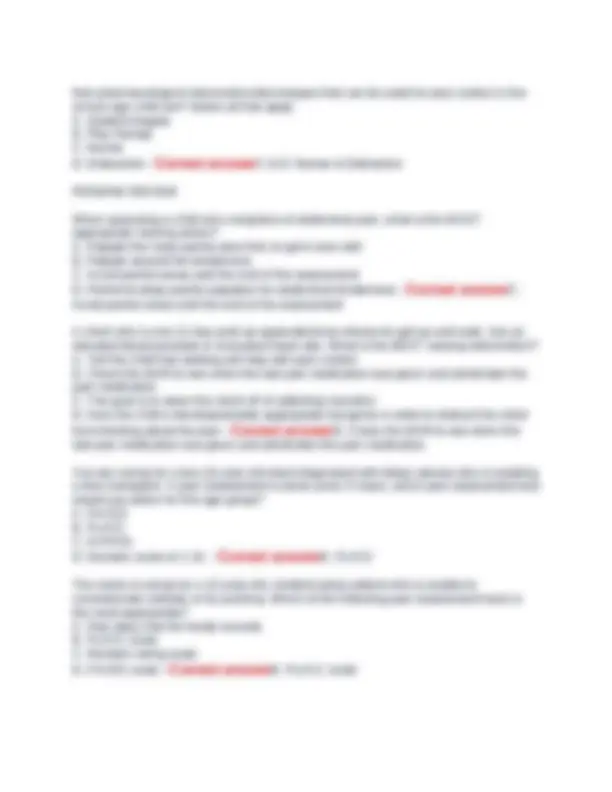
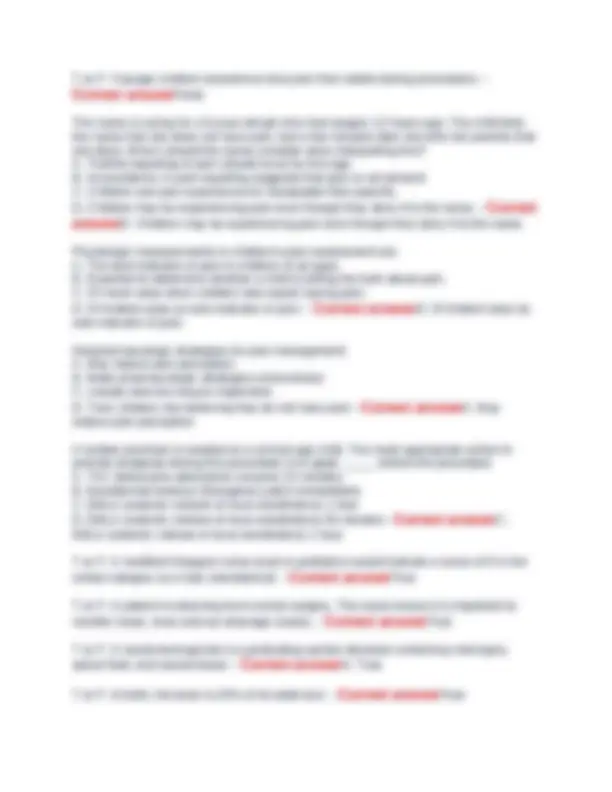
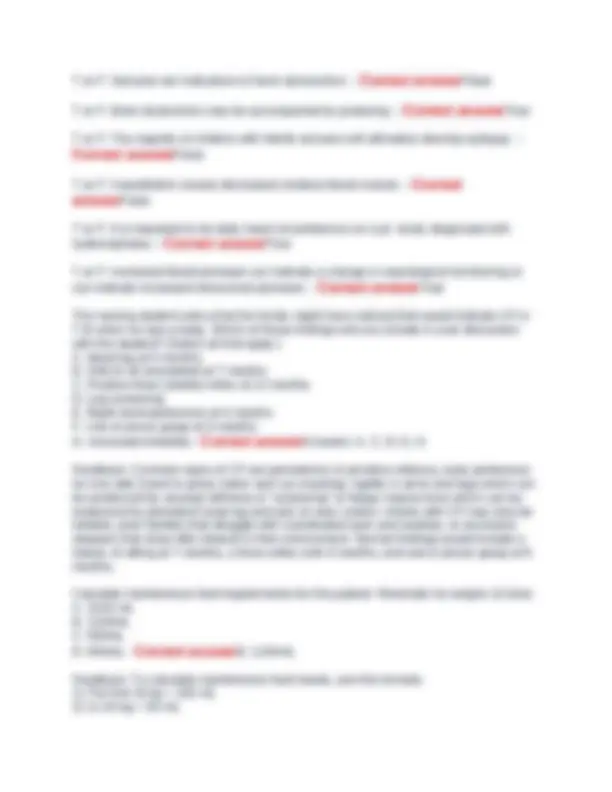
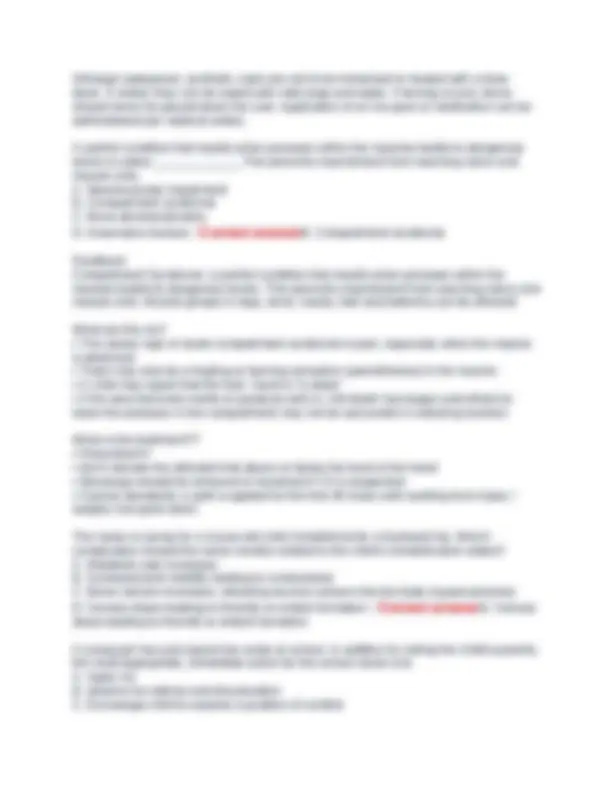
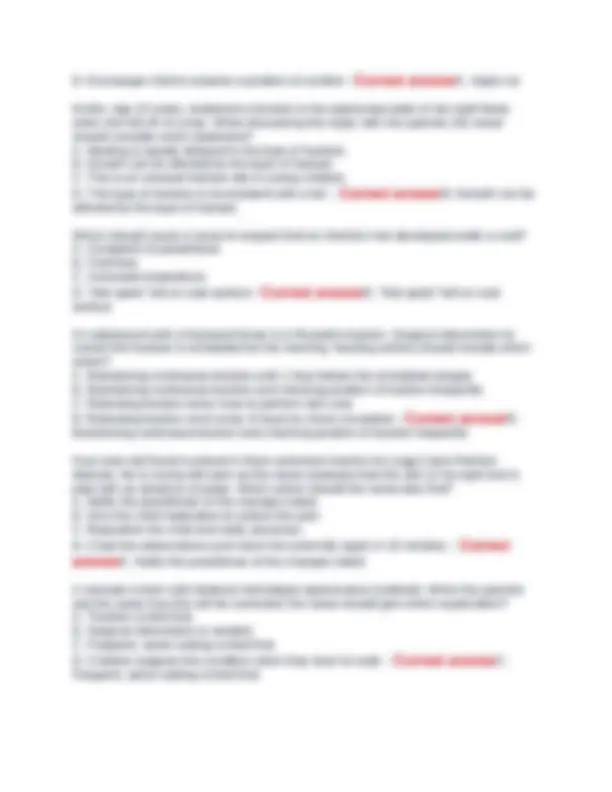
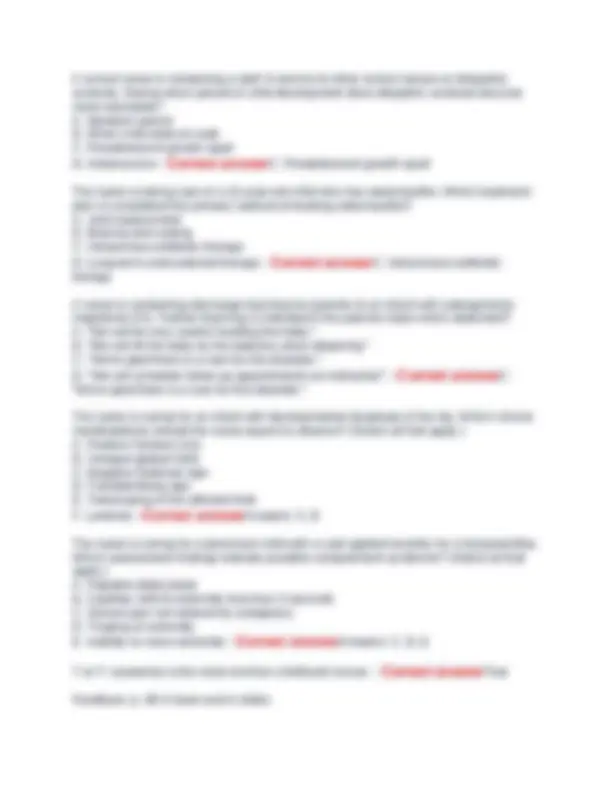


Study with the several resources on Docsity

Earn points by helping other students or get them with a premium plan


Prepare for your exams
Study with the several resources on Docsity

Earn points to download
Earn points by helping other students or get them with a premium plan
Community
Ask the community for help and clear up your study doubts
Discover the best universities in your country according to Docsity users
Free resources
Download our free guides on studying techniques, anxiety management strategies, and thesis advice from Docsity tutors
PEDS Final Exam (Modules; 62 Practice Questions).>PEDS Final Exam (Modules; 62 Practice Questions).>
Typology: Exams
1 / 11

This page cannot be seen from the preview
Don't miss anything!







A child comes in with Tachycardia and delayed capillary refill, this child is currently is in shock. What other s/s would indicate a LATE sign of shock in children? A. Fever B. Restlessness C. Decreased B/P
T or F: Ipecac is the recommended home remedy for routine poison treatment -
What are signs of symptoms of Lead positioning (select all that apply) A. Nausea and Vomiting B. Increased activity C. Seizure D. No pain E. Lethargy
C. Seizure E. Lethargy F. Constipation In School-age children, what is the most common type of poisoning? A. Chemical B. Lead C. Acetaminophen (Tylenol)
Which is a clinical manifestation of acetaminophen poisoning? A. Hyperpyrexia B. Hepatic involvement C. Severe burning pain in stomach
Which is the most frequent source of acute childhood lead poisoning? A. Folk remedies B. Unglazed pottery C. Lead-based paint
Cardiopulmonary resuscitation (CPR) is begun on a toddler. Which pulse is usually palpated because it is the most central and accessible? A. Radial
B. Carotid C. Femoral
Which drug is considered the most useful in treating childhood cardiac arrest? A. Bretylium tosylate (Bretylium) B. Lidocaine hydrochloride (Lidocaine) C. Epinephrine hydrochloride (Adrenaline)
Effective lone-rescuer CPR on a 5-year-old child should include A. Two breaths to every 30 chest compressions B. Two breaths to every 15 chest compressions C. Reassessment of child after 50 cycles of compression and ventilation.
Two breaths to every 30 chest compressions The Heimlich maneuver is recommended for airway obstruction in children older than _____ year(s). A. 1 B. 4 C. 8
A nurse is caring for a child in acute respiratory failure. Which blood gas analysis indicates the child is still in respiratory acidosis? A. pH 7.50, CO2 48 B. pH 7.30, CO2 30 C. pH 7.32, CO2 50
The nurse enters a room and finds a 6-year-old child who is unconscious. After calling for help and before being able to use an automatic external defibrillator, which steps should the nurse take. a. Place on a hard surface b. Administer 30 chest compressions with two breaths c. Feel carotid pulse while maintaining head tilt with the other hand d. Use the head tilt-chin lift maneuver and check for breathing e. Place heel of one hand on lower half of sternum with other hand on top f. Give two rescue breaths A. c, a, f, d, e, b B. I have no idea C. a, d, f, c, e, b
T or F: Younger children experience less pain than adults during procedures. -
The nurse is caring for a 6-year-old girl who had surgery 12 hours ago. The child tells the nurse that she does not have pain, but a few minutes later she tells her parents that she does. Which should the nurse consider when interpreting this? A. Truthful reporting of pain should occur by this age. B. Inconsistency in pain reporting suggests that pain is not present. C. Children use pain experiences to manipulate their parents.
Physiologic measurements in children's pain assessment are: A. The best indicator of pain in children of all ages. B. Essential to determine whether a child is telling the truth about pain. C. Of most value when children also report having pain.
sole indicator of pain. Nonpharmacologic strategies for pain management: A. May reduce pain perception B. Make pharmacologic strategies unnecessary C. Usually take too long to implement.
reduce pain perception A lumbar puncture is needed on a school-age child. The most appropriate action to provide analgesia during this procedure is to apply _____ before the procedure. A. TAC (tetracaine-adrenaline-cocaine) 15 minutes B. transdermal fentanyl (Duragesic) patch immediately C. EMLA (eutectic mixture of local anesthetics) 1 hour
EMLA (eutectic mixture of local anesthetics) 1 hour T or F: A modified Glasgow coma scale in pediatrics would indicate a score of 5 in the
T or F: A patient is returning from cranial surgery. The nurse knows it is important to
T or F: A myelomeningocele is a protruding saclike structure containing meninges,
T or F: The majority of children with febrile seizures will ultimately develop epilepsy. -
T or F: It is important to do daily head circumference on a pt. newly diagnosed with
T or F: Increased blood pressure can indicate a change in neurological functioning or
The nursing student asks what the family might have noticed that would indicate CP in T.M.when he was a baby. Which of these findings will you include in your discussion with the student? (Select all that apply.) A. Head lag at 5 months B. Able to sit unassisted at 7 months C. Positive Moro (startle) reflex at 12 months D. Leg scissoring E. Right-hand preference at 6 months F. Use of pincer grasp at 9 months
Feedback: Common signs of CP are persistence of primitive reflexes, early preference for one side (hand or gross motor such as crawling), rigidity in arms and legs which can be evidenced by unusual stiffness or "scissoring" or floppy muscle tone which can be evidenced by persistent head lag and lack of neck control. Infants with CP may also be irritable, poor feeders that struggle with coordinated suck and swallow, or excessive sleepers that show little interest in their environment. Normal findings would include a history of sitting at 7 months, a Moro reflex until 4 months, and use of pincer grasp at 9 months. Calculate maintenance fluid requirements for this patient. Reminder he weighs 12 kilos. A. 2100 mL B. 1100mL C. 500mL
Feedback: To calculate maintenance fluid needs, use this formula:
and to address challenging mobility issues. This would include keeping bed in lowest position, side rails up and padded, and safety equipment (O 2 and suction) at the bedside Which of these nonpharmacologic interventions would be age appropriate for this patient? (Select all that apply.) A. Encourage "positive self-talk" such as statements like, "I will feel better when the cast B. Offer a favorite DVD or video. C. Use bubbles to "blow the hurt away." D. Educate T.M. on pain and relationship to the procedure. E. Read a favorite book.
Feedback: These are appropriate strategies that would relax and distract a 3-year-old. A, D, and F would be appropriate for an older patient Patient can PO ad lib. Resume home schedule of 520 mL PediaSure via G-tube from 10 PM to 6 AM. What is the hourly rate you will set your pump? A. 520/mL/hr B. 22.5mL/hr C. 65mL/hr
Feedback: 520 mL divided by 8 hours is 65 mL/hr. You will set your hourly rate at 65 mL/hr and amount to be delivered at 520 mL. Which of these statements by T.M.'s mother would indicate that further education is needed? (Select all that apply.) A. "I need to check the toes on T.'s feet several times a day for the first week or so to see if they are warm and he is able to wiggle them." B. "I need to keep his feet elevated when I get him home." C. "It is okay if I give him a tub bath. Because it is a synthetic cast, I can dry it with a blow dryer." D. "Because T. uses pull-up diapers, I will need to use plastic tape to protect the cast opening." E. "If he has an itch, it is okay to use a knitting needle to scratch under the cast." -
Feedback: Elevating and checking neurovascular status is appropriate. If the child is incontinent and uses diapers, the opening of the cast will need to be protected.
Although waterproof, synthetic casts are not to be immersed or heated with a blow dryer. If soiled, they can be wiped with mild soap and water. If itching occurs, items should never be placed down the cast. Application of an ice pack or medication can be administered per medical orders. A painful condition that results when pressure within the muscles builds to dangerous levels is called _____________ This prevents nourishment from reaching nerve and muscle cells. A. Neurovascular impairment B. Compartment syndrome C. Bone demineralization
Feedback: Compartment Syndrome: a painful condition that results when pressure within the muscles builds to dangerous levels. This prevents nourishment from reaching nerve and muscle cells. Muscle groups in legs, arms, hands, feet and buttocks can be affected What are the s/s?
stasis leading to thrombi or emboli formation A young girl has just injured her ankle at school. In addition to calling the child's parents, the most appropriate, immediate action by the school nurse is to A. Apply ice B. observe for edema and discoloration C. Encourage child to assume a position of comfort
A school nurse is conducting a staff in-service to other school nurses on idiopathic scoliosis. During which period of child development does idiopathic scoliosis become most noticeable? A. Newborn period B. When child starts to walk C. Preadolescent growth spurt
The nurse is taking care of a 10-year-old child who has osteomyelitis. Which treatment plan is considered the primary method of treating osteomyelitis? A. Joint replacement B. Bracing and casting C. Intravenous antibiotic therapy
therapy A nurse is conducting discharge teaching for parents of an infant with osteogenesis imperfecta (OI). Further teaching is indicated if the parents make which statement? A. "We will be very careful handling the baby." B. "We will lift the baby by the buttocks when diapering." C. "We're glad there is a cure for this disorder."
"We're glad there is a cure for this disorder." The nurse is caring for an infant with developmental dysplasia of the hip. Which clinical manifestations should the nurse expect to observe? (Select all that apply.) A. Positive Ortolani click B. Unequal gluteal folds C. Negative Babinski sign D. Trendelenburg sign E. Telescoping of the affected limb
The nurse is caring for a preschool child with a cast applied recently for a fractured tibia. Which assessment findings indicate possible compartment syndrome? (Select all that apply.) A. Palpable distal pulse B. Capillary refill to extremity less than 3 seconds C. Severe pain not relieved by analgesics D. Tingling of extremity
Feedback: p. 88 in book and in slides
T or F: Osteosarcoma is a malignant tumor of the bone derived from osteoid tissue. -
T or F: Patients with Hodgkin's lymphoma present with painful, nonmovable, progressive lymph node enlargement and weight gain. It occurs more frequently in
T or F: Symptoms of leukemia include anemia, neutropenia, and absence of blood
T or F: When a child has an ANC less than 500 he is neutropenic and there is a high
Feedback: knowing if an ANC is low because when a hem onc pt has a low ANC you worry about then getting an infection and not having the ability to fight it. T or F: Children who are receiving chemotherapy are not immunized against live viral vaccines ( MMR) until the immune system is capable of responding appropriately to the
Feedback: Nursing tip in book page 890. T or F: Chemotherapy doses for children are most often calculated according to the
T or F: A nurse notices a white area within the pupil while doing a PE on a 6 month old.
Feedback: Retinoblasoma. May have a family history. May present with stabismus. these pts are followed for a long time. Tumors that involve more than 1/2 retina have worse prognosis. Ewings is tumors of the flat bones...chest, vertebra, pelvis.This info can be found in your slides. T or F: Childhood survivors have a decreased chance of acquiring another cancer later